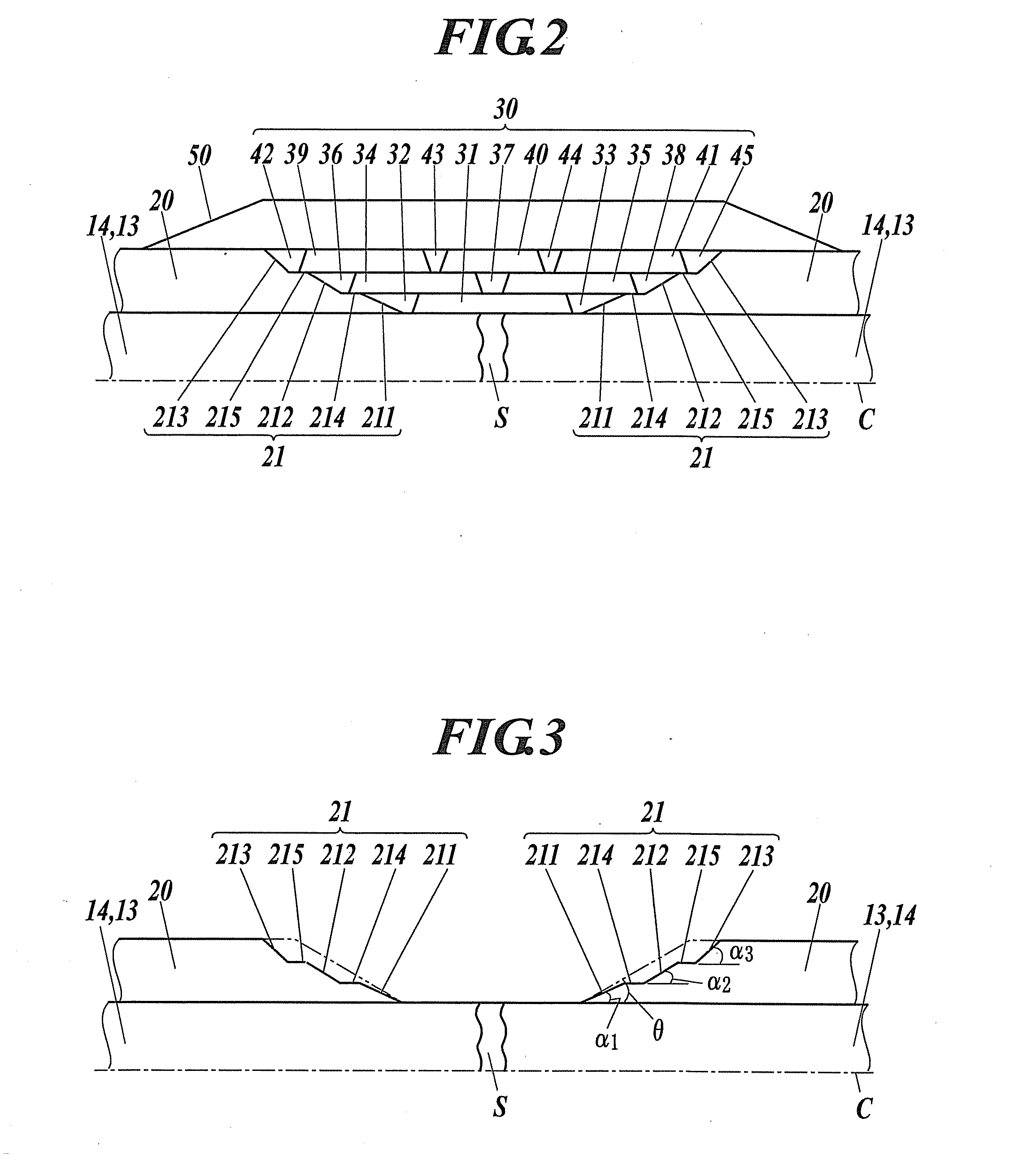Connection structure for superconducting cables
a superconducting cable and connection structure technology, applied in the direction of superconducting magnets/coils, insulated conductors, cables, etc., can solve the problems of increased increased resistance to electrical gradient along the taper surface of the taper shape portion, and reduced resistance to electrical field stress in the stratabound direction. , to achieve the effect of reducing the overall length of the taper portion, suppressing the occurrence of electrical breakdown in the stratabound direction
- Summary
- Abstract
- Description
- Claims
- Application Information
AI Technical Summary
Benefits of technology
Problems solved by technology
Method used
Image
Examples
first embodiment
[0045]Hereinafter, a first embodiment will be described with reference to the drawings.
[0046]FIG. 1 is a diagram illustrating an example of superconducting cable to be laid, and FIG. 2 is a cross-sectional view illustrating a major connection structure of a cable core in an intermediate connecting part of the superconducting cable.
[0047][Superconducting Cable]
[0048]The superconducting cable 10 illustrated in FIG. 1 is a single-core-type superconducting cable in which a single-core cable core 11 is housed in a thermal insulation tube 12. The cable core 11 is composed of a former 13, superconductive conductor layers 14, an electric insulating layer 20, superconducting shield layers 15, a normal conducting shield layer 16, a protecting layer 17, etc.
[0049]The former 13 is a core for winding, which is used to form the cable core 11, and for example, constructed by twisting a normal conducting wire such as a copper wire. Into the former 13, fault current flowing through the superconducti...
second embodiment
[0123]Although the taper shape portion 21 of the first embodiment is composed of three tapered portions 211, 212, 213, it can be composed of a greater number of tapered portions, or composed of a smaller number, two, of tapered portions. In a second embodiment, as illustrated in FIG. 12, the case that each taper shape portion 21A includes the first tapered portion 211, the second tapered portion 212, and the first equal diameter portion 214 will be described. Also in this case, inclination angle α1 of the first tapered portion 211, inclination angle α2 of the second tapered portion 212, and inclination angle θ of a conventional taper shape portion including a single tapered surface are set so that α12, α12>θ. Specifically, they are set so that α1=2.3, α2=4.2 (θ=3.45 degrees).
[0124]Moreover, in the case that the equal diameter portion 214 is not considered, in x-y coordinate system in which the direction along the cable centerline C is defined as x and the cable radial direction cent...
third embodiment
[0135]In a third embodiment, as illustrated in FIG. 15, the taper shape portion 21B has the feature of being composed of a plurality (for example, n) of the first to nth stepwise tapered portions 211B, 212B, 213B, . . . , and having inclination angles α1 to αn of the first to nth tapered portions 211B, 212B, 213B, . . . set so as to fulfill following condition formulas (7) to (12).
[0136]Incidentally, though the case that no equal diameter portion (no step portion) is provided at boundaries between the tapered portions is illustrated in the example of FIG. 15, it is also possible to provide the equal diameter portions (step portions). Additionally, in the case of providing the equal diameter portions (step portions), the overall length of the equal diameter portions (step portions) is added to each value of X2 to Xn.
[Formula7][FIRSTSTEP]A·sinα1y<1(r≦y<Y1),y=r+x·tanα1(0≦x<X1)(7)[SECONDSTEP]A·sinα2y<1(Y1≦y<Y2),y=r+X1tanα1+(x-X1)tanα2(X1≦x<X2)(8)[THIRDSTEP]A·sinα3y<...
PUM
| Property | Measurement | Unit |
|---|---|---|
| length | aaaaa | aaaaa |
| length | aaaaa | aaaaa |
| width | aaaaa | aaaaa |
Abstract
Description
Claims
Application Information
 Login to View More
Login to View More - R&D
- Intellectual Property
- Life Sciences
- Materials
- Tech Scout
- Unparalleled Data Quality
- Higher Quality Content
- 60% Fewer Hallucinations
Browse by: Latest US Patents, China's latest patents, Technical Efficacy Thesaurus, Application Domain, Technology Topic, Popular Technical Reports.
© 2025 PatSnap. All rights reserved.Legal|Privacy policy|Modern Slavery Act Transparency Statement|Sitemap|About US| Contact US: help@patsnap.com



